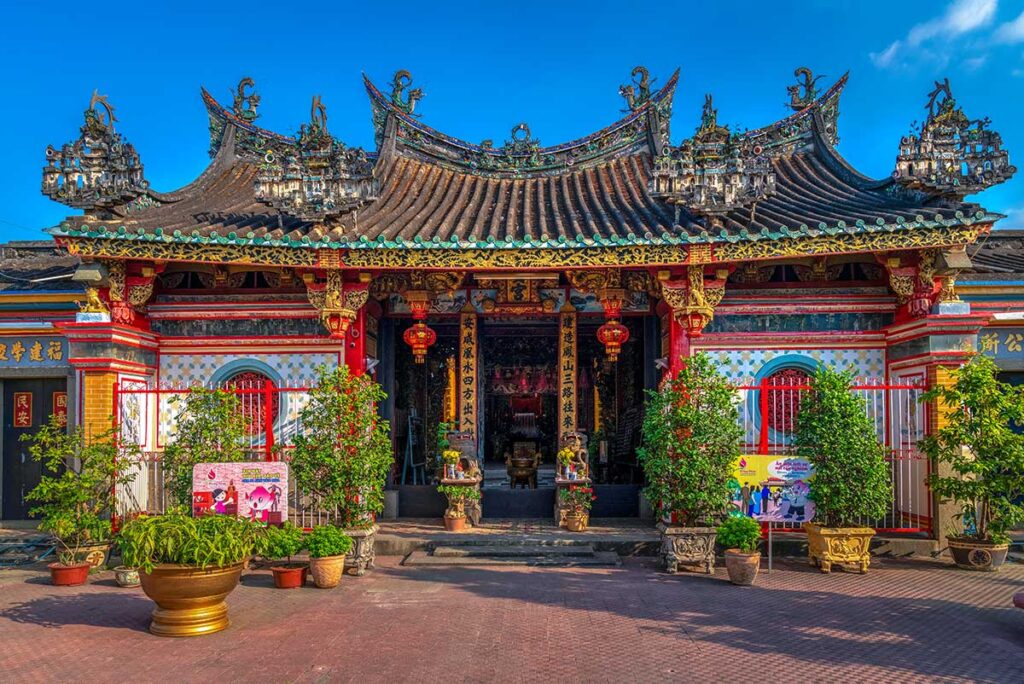What is Kien An Cung Temple?
Kien An Cung Temple, also known as the Sa Dec Hokkien Assembly Hall or Ong Quach Pagoda, is a Chinese-style temple built by Fujianese immigrants in the late 1920s. For the Chinese community that once played an important role in Sa Dec’s trading life, the temple was more than a place of worship—it was also a meeting point, a cultural anchor, and a link to their ancestral traditions.
Today, Kien An Cung is recognized as a national historical relic (since 1990) and stands out as one of Sa Dec’s main heritage landmarks. It isn’t large or grand compared to some temples in bigger cities, but its detailed carvings, traditional layout, and calm atmosphere make it a meaningful stop for anyone exploring the old town. Visitors will find that the temple feels both solemn and approachable—an authentic piece of Sa Dec’s multicultural past that has been carefully preserved.
History of Kien An Cung Temple
Kien An Cung Temple was constructed between 1924 and 1927 by members of the Fujianese (Hokkien) community who had settled in Sa Dec. The effort was led by a wealthy businessman named Huynh Thuan, who helped mobilize support and funding from fellow immigrants. For the community, the temple was not just a spiritual site but also a social and cultural center where people could gather, maintain traditions, and support one another in a new land.
The main deity worshipped here is Ong Quach, also known as Quang Trach Ton Vuong, a protective figure highly revered among the Fujianese. Alongside him, the temple houses altars to other gods and historical figures, reflecting the blend of religious and cultural practices brought from southern China.
Two important annual ceremonies are still held according to the lunar calendar: Ong Quach’s birthday on the 22nd day of the second month, and his enlightenment day on the 22nd of the eighth month. These occasions draw both devotees and curious visitors, and they keep alive the traditions that the temple was built to preserve.
Beyond its religious role, Kien An Cung functioned as a hub for the local Chinese community in Sa Dec, offering a space for meetings, discussions, and cultural continuity. Its recognition as a national historical relic in 1990 highlights the lasting significance of this heritage site in the Mekong Delta.
Architecture and Highlights
1. Exterior and Layout
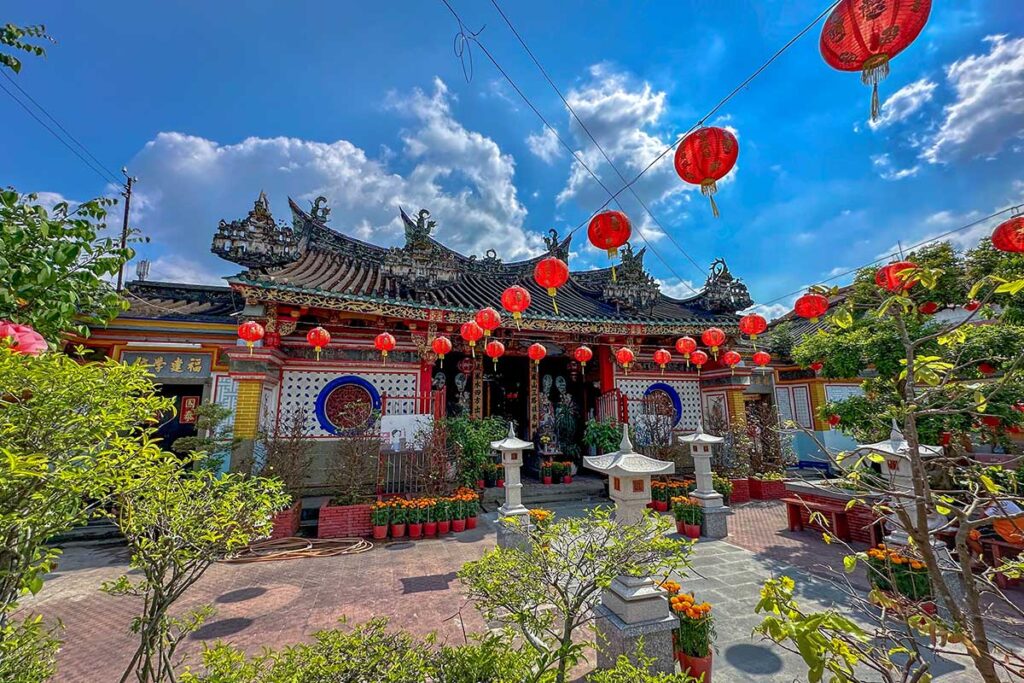
Kien An Cung Temple was designed in the shape of the Chinese character “gong” (工), a layout often used in traditional assembly halls. It faces the Cai Son canal, which historically brought both trade and cultural exchange to Sa Dec.
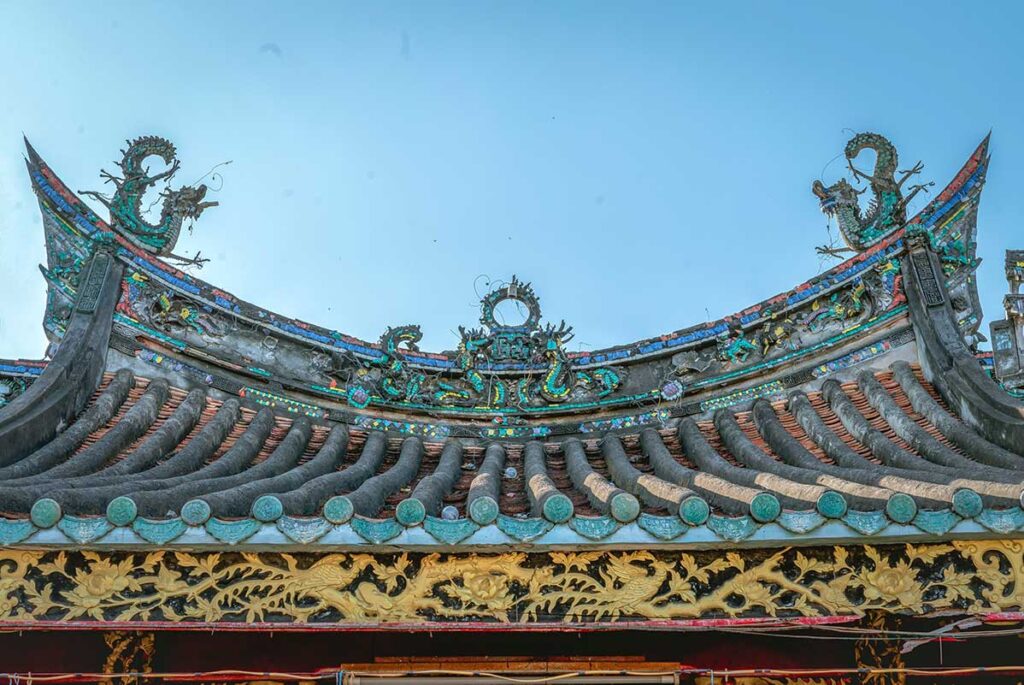
The roof is covered with yin-yang tiles and decorated with dragon motifs, symbolizing prosperity and protection. At the roof’s crest, two dragons embrace a moon, while six miniature palace-like structures rise from the curved rooflines.
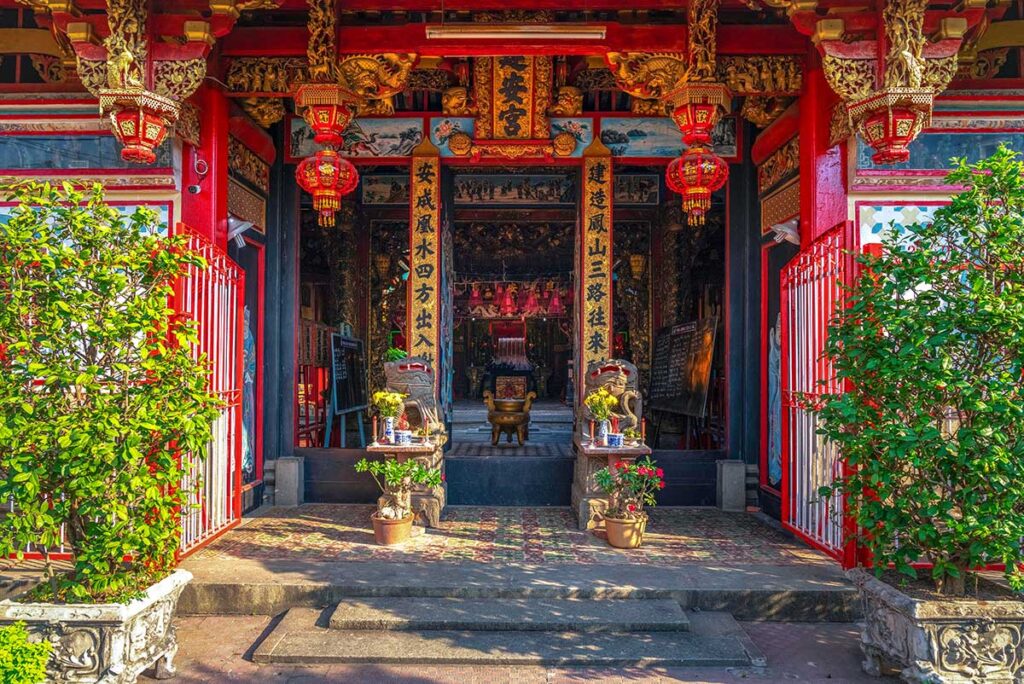
At the entrance, visitors are greeted by two large stone unicorns, carved from green stone, which serve as guardians of the temple. The doorways are flanked by depictions of deities representing Good and Evil—common figures in Chinese temple design, reminding worshippers of the balance between virtues and vices.
2. Interior features
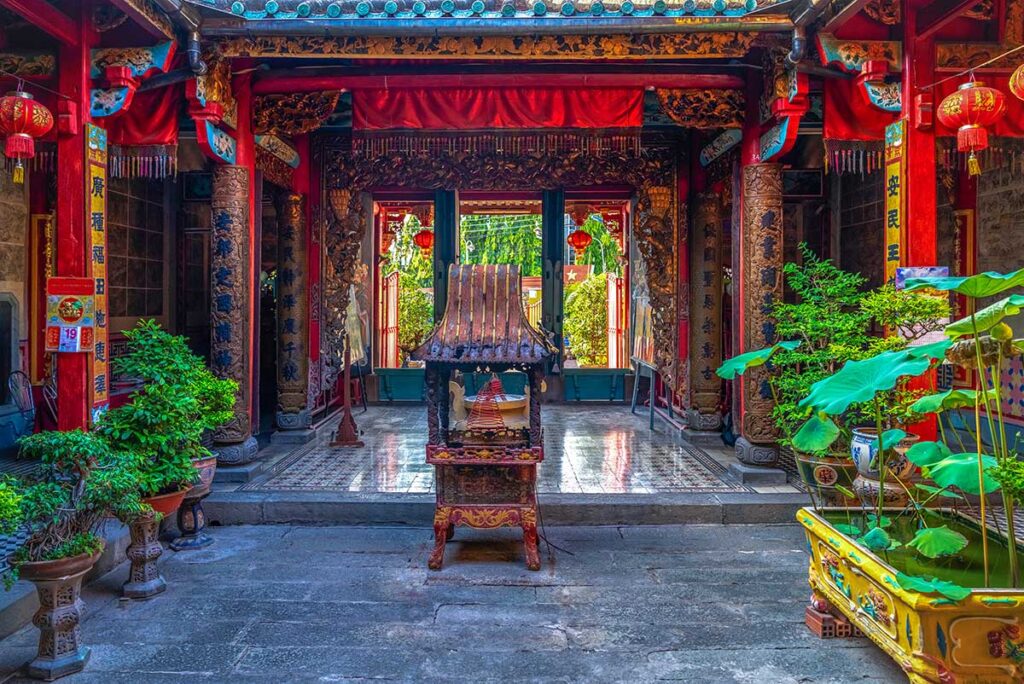
Stepping inside, the temple opens to a small inner courtyard known as the celestial “sky well.” This architectural feature provides natural light and ventilation, while also helping to clear the air during crowded ceremonies when incense smoke fills the hall.
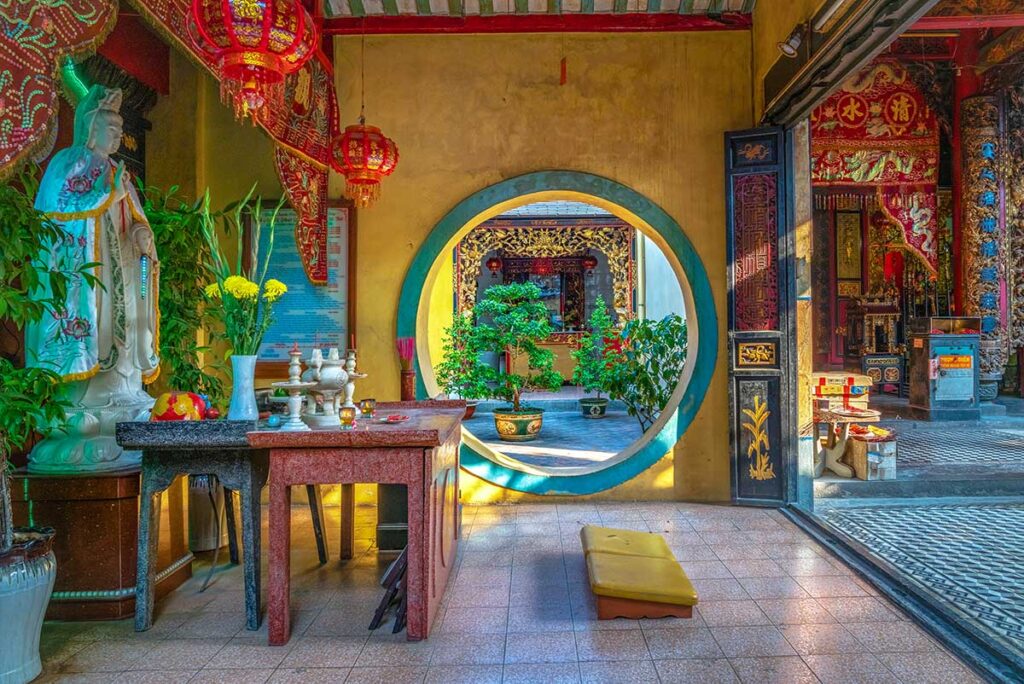
The interior is supported by glossy black wooden columns, each wrapped in gilded couplets and Chinese inscriptions that praise virtues and deities. Around the halls, intricate wall paintings illustrate classic Chinese tales such as Journey to the West and Romance of the Three Kingdoms, blending moral lessons with decorative art. Visitors will also notice detailed wood carvings, silk embroideries, and tapestries, each adding to the temple’s layered sense of craftsmanship.
3. Altars and Worship
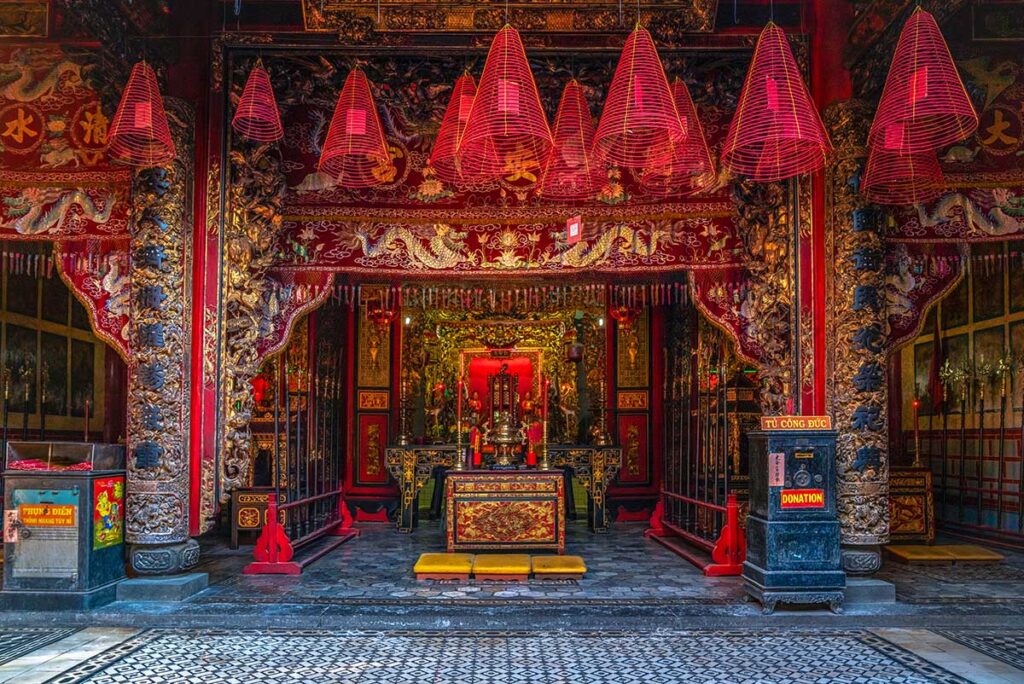
At the center of the main hall is the altar of Ong Quach, the protective deity worshipped by the Fujianese community. In front of him stands a statue of Quan Thanh (Emperor Guan Yu), a legendary Chinese general often honored as a symbol of loyalty and integrity. Rows of ceremonial weapons line the space, reflecting the martial associations of these figures.
On either side of the hall are the east and west lounges, which function as spaces for visitors to sit, talk, or wait during ceremonies. These practical features underline that Kien An Cung was not only a religious site but also a community gathering place.
Huynh Thuy Le Ancient House
Just a few minutes’ walk from Kien An Cung Temple, you’ll find the Huynh Thuy Le Ancient House—another of Sa Dec’s most notable landmarks. The house belonged to Huynh Thuy Le, a wealthy Chinese-Vietnamese businessman whose family played a major role in local trade and community life. He is also remembered internationally for his connection to the French writer Marguerite Duras, whose novel The Lover was inspired by their relationship.
Huynh Thuy Le’s family contributed significantly to the construction of Kien An Cung, helping the Fujianese community complete their assembly hall in the 1920s. Visiting both sites together gives a fuller picture of how the Chinese merchant class shaped Sa Dec’s history and left behind a unique cultural legacy.
Since the house is located only about 200 meters from the temple, most visitors combine the two in a single stop. For a deeper look, you can read our full guide to the Huynh Thuy Le Ancient House.
Practical visiting information & Tips
Getting there
Kien An Cung Temple is located at 39 Phan Boi Chau Street, Ward 1, Sa Dec, right in the old town. If you’re already exploring central Sa Dec, it’s an easy stop on foot or by bicycle. From nearby cities like Can Tho or Dong Thap, you can reach Sa Dec by car in about 1–2 hours, making the temple a convenient addition to a Mekong Delta day trip.
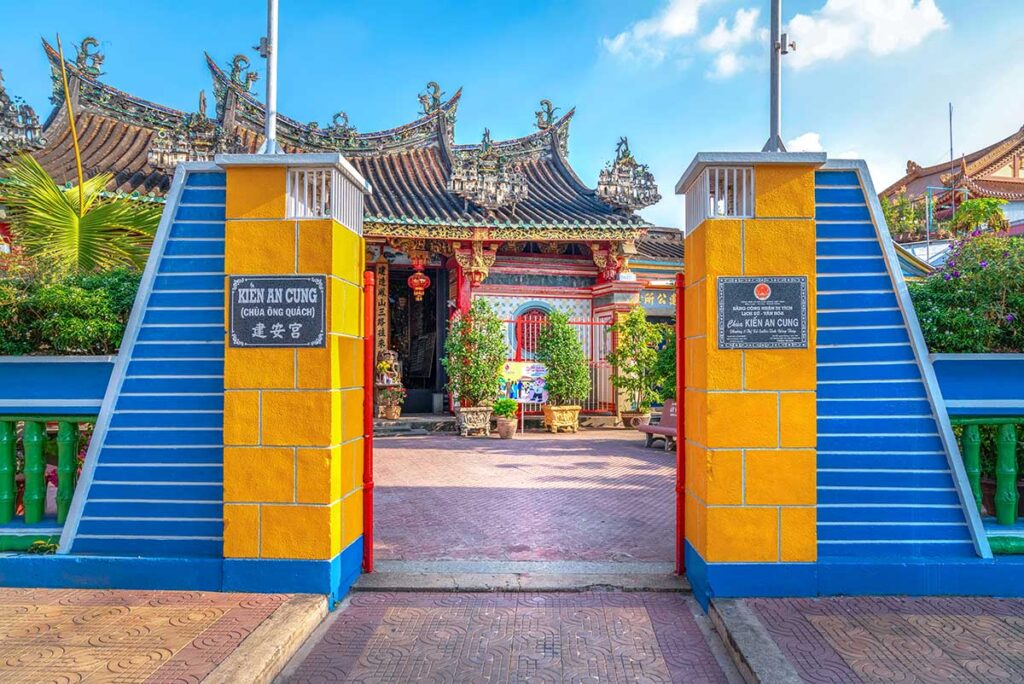
Entrance fee & Opening hours
There is no official entrance fee—visitors may leave a small donation, but it’s not expected. The temple generally opens during daylight hours (around 07:00–18:00), though times are not strictly enforced. It’s best to visit in the morning or early afternoon when the site is at its quietest.
Etiquette & Dress code
As with other religious sites in Vietnam, it’s respectful to dress modestly, with shoulders and knees covered. Photography is allowed, but avoid using flash inside, especially near the altars. Eating or drinking inside the temple is discouraged. A quiet, respectful attitude will help preserve the peaceful atmosphere that both worshippers and visitors appreciate.
Nearby sights
Kien An Cung is in the heart of Sa Dec’s historic quarter, making it easy to combine with other attractions. Just a short walk away is the Huynh Thuy Le Ancient House, and a few minutes by car or bike brings you to the Sa Dec Flower Village, which is especially vibrant in the weeks leading up to Tet.
If you’re exploring further afield in Dong Thap, places like Xeo Quyt Forest and Tram Chim National Park are excellent additions for nature lovers.
To cover the whole area of things to do, read our guide of Dong Thap.
Extra visiting tips
- The temple is relatively small, so most visitors spend 30–60 minutes inside.
- Mornings are cooler and more comfortable for walking around; afternoons can get hot.
- Unlike more famous pagodas in Vietnam, Kien An Cung is usually calm and not crowded, which makes it pleasant to explore at your own pace.
Is Kien An Cung Temple worth visiting?
Kien An Cung Temple is a worthwhile stop if you’re already in Sa Dec. Its architecture, detailed carvings, and calm atmosphere give a good sense of the city’s Chinese heritage, and it’s small enough to explore without taking much time.
The temple is best enjoyed as part of a wider walk around Sa Dec’s old quarter. Combining it with the nearby Huynh Thuy Le Ancient House and the Sa Dec Flower Village makes for a well-rounded visit that balances history, architecture, and local culture.
That said, Kien An Cung on its own isn’t a reason to travel to Sa Dec. It’s more of a meaningful stop within a broader itinerary rather than a headline attraction.
